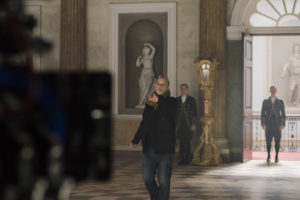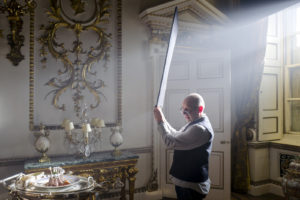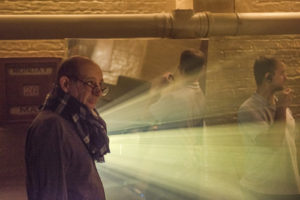 During 20 tense days, Prime Minister Winston Churchill (Gary Oldman) must decide whether he will negotiate peace with Hitler, or rally the British people, Parliament and King to take on the fight to save the freedom and ideals of the British nation.
During 20 tense days, Prime Minister Winston Churchill (Gary Oldman) must decide whether he will negotiate peace with Hitler, or rally the British people, Parliament and King to take on the fight to save the freedom and ideals of the British nation.
Mirroring the darkest hours that Churchill experiences in his decision to take England to war, the dark, generally, monochromatic palette of the film comes from the collaboration between cinematographer, Bruno Delbonnel, production designer, Sarah Greenwood, and costume designer, Jacqueline Durran.
Having collaborated with Greenwood even more times than with director, Joe Wright, Durran first long conversation about the film was with Greenwood.
“I find out what her interpretation is. It is critically important for the costume and production designers to work together,” stated Durran. “We have to know what sort of world we are creating and how the costumes are going to work either in contrast or in harmony with the sets.”
In her past work with Wright, Durran used a lot of stylization – such as in her Oscar-winning Costume Design for Anna Karenina – so she wanted to know Wright’s take on this particular period and what they wanted to achieve.
“We didn’t want to stylize it. We wanted it to be real,” said Durran. “When you are making something real, you still have to interpret. For the members of Parliament and for Churchill, I was working a lot from photographs and really trying to replicate to a degree what they actually looked like, but not slavishly.”
 Because actors were not necessarily cast to look exactly like the people, interpretations were made, but some historical facts were replicated. Viscount Halifax, (Stephen Dillane) actually had a gloved prosthetic hand and wore his sleeve longer on one side to try and obscure that fact. That kind of defining characteristic in the costuming helped in designing a show with a predominantly male cast.
Because actors were not necessarily cast to look exactly like the people, interpretations were made, but some historical facts were replicated. Viscount Halifax, (Stephen Dillane) actually had a gloved prosthetic hand and wore his sleeve longer on one side to try and obscure that fact. That kind of defining characteristic in the costuming helped in designing a show with a predominantly male cast.
“We replicated things like that, things that are kind of quirky and interesting about the person that were really part of their character,” revealed Durran. “With Churchill, we tried to replicate what he was wearing. He’s iconic in Britain. There’s a book called “Churchill Style’ about where he got his clothes and how he dressed.”
The production went back to some of the companies or tailors that had made clothes for Churchill. Henry Poole made suits for the prime minister “until 1942 when they fell out.” Durran had Henry Poole make suits for Oldman. She had fun going back and reconnecting the historical fact with the designs for the film.
 Close to the start of the project, Durran traveled to Los Angeles for a fitting with Oldman, prosthetic make-up and hair artist, Kazuhiro Tsuji, Wright, and the producers. Durran thinks it impossible to judge body shape without seeing it clothed; the same with the fat suit that Oldman wore to duplicate Churchill’s well-know form. It took three fittings to get the “shoulders, the roundness of the back, the shape of the stomach” and all the other elements for Churchill’s shape right.
Close to the start of the project, Durran traveled to Los Angeles for a fitting with Oldman, prosthetic make-up and hair artist, Kazuhiro Tsuji, Wright, and the producers. Durran thinks it impossible to judge body shape without seeing it clothed; the same with the fat suit that Oldman wore to duplicate Churchill’s well-know form. It took three fittings to get the “shoulders, the roundness of the back, the shape of the stomach” and all the other elements for Churchill’s shape right.
Durran enjoyed “interpreting” Churchill’s dressing gown, which the character wears when we first see him in the film. This introduction forms a strong, lasting impression of the character.
Although there is reference that the dressing gown was silk, there were no a color photos, and descriptions of the robe contradicted each other. Not knowing the historical color, Wright requested pink. The tone of the pink was chosen for compatibility with the bedroom color. Fabric was woven in a bold pattern to balance the color. The nightshirt was monogrammed.
With Clementine Churchill’s costumes, reproducing reference photos meant interpreting her style into costumes that actress Kristin Scott Thomas could work with.
One element of stylization in the film was Wright’s specific request for the whole Parliament scene to be in black and white, even the women. Although it might seem a simple task, Durran remarked, “Finding five hundred period, black suits is quite hard.”
The company had meetings to decide the crowd breakdown – workers, market stall holders, drivers–in the slow-motion street scenes so they would be dressed appropriately and have the right props to make each of their respective background characters believable.
“We found photographs of a very neutral palette. There was a particular photographer that summed it up the best. Gisele Freund did portraiture and kept the colors very cool. She would put in spots of color. I’d never done this period in that way,” commented Durran. “Each different project has a different mood, a different tone.”





